Secrets Of Longevity Hidden In Your Pulse Wave

Sitting for long periods is now known to be a health hazard. Mobility, especially Core Mobility, is beneficial for health in ways only recently being recognized by Western Medicine. Yoga, Tai Chi, and other similar arts have for centuries emphasized the importance of spinal mobility and the benefits of diaphragmatic breathing.
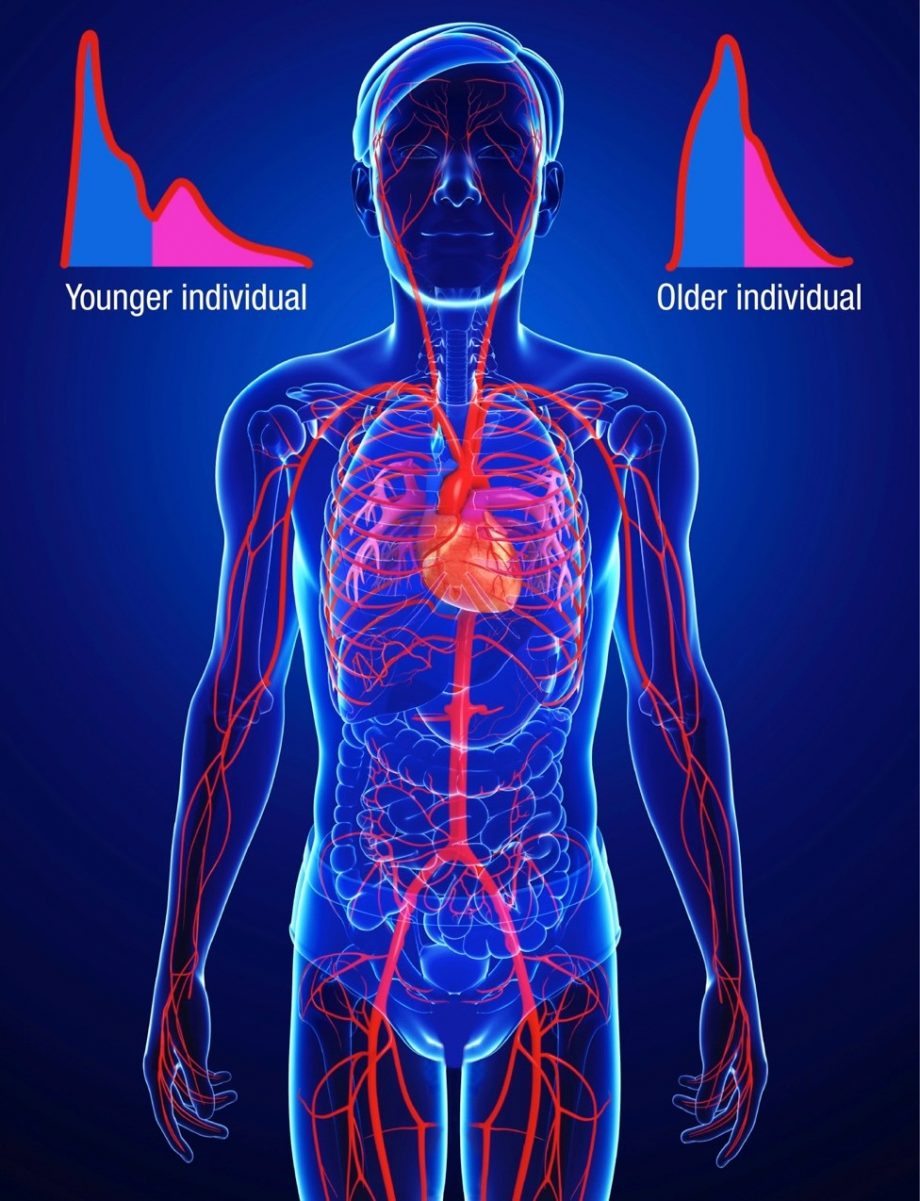
Aortic Stiffness is a novel integrative health metric with the ability to act as a bridge, connecting ancient Eastern wisdom and modern medical scientific understanding. Aortic Stiffness has been studied by medical scientists for about twenty years and remarkably predicts the risk of death from all causes. Aortic Stiffness is unique in its ability to assess overall health and estimate lifespan. Aortic Stiffness has also been shown to improve with attention to exercise, diet and stress management. Aortic Stiffness is a single health metric able to guide people towards healthy lifestyle choices.
The Aorta runs from the heart through the chest and abdomen as shown in the picture below.
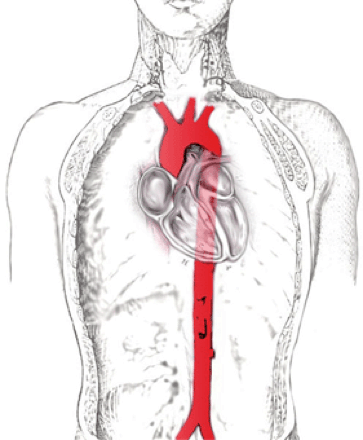
The Aorta runs immediately in front of the spinal column as shown in the drawing below.
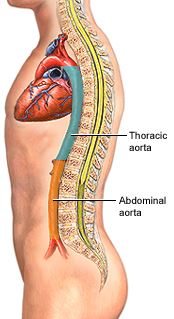
Aortic Stiffness is a measure of stiffness along the spinal axis and as such is a measure of Core Mobility.
The body's organization can be regarded as consisting of four cavities as shown below. The cavities define the body’s core regions and mobility of these regions is Core Mobility.
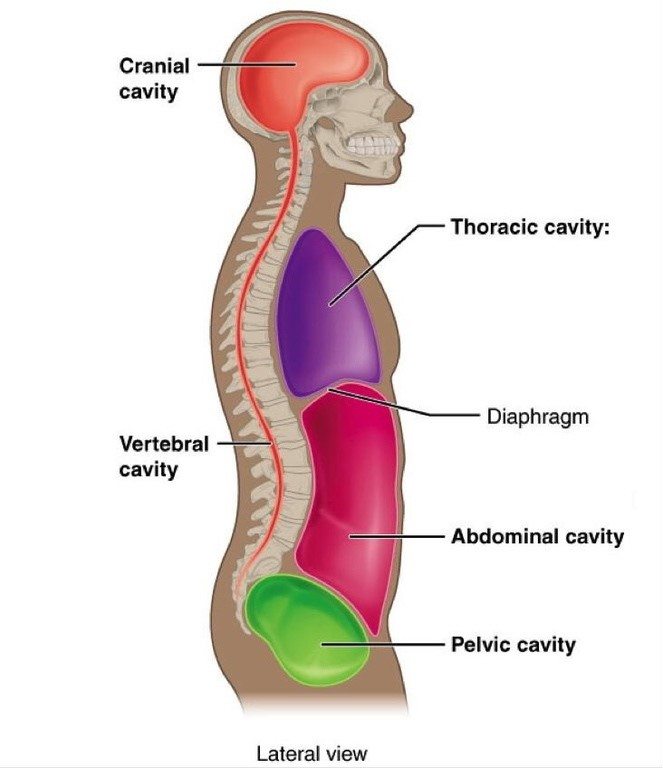
Each of these internal cavities relies on movement to maintain organ function and health. The spine connects these cavities and spinal stiffness affects the stiffness of the rib cage, soft tissue, skull and pelvic structures. With increasing stiffness of the spine and rib cage, movement of the diaphragm (separating the chest and abdominal cavities) is restricted.
The diaphragm muscle contracts with each breath, compressing the sponge-like liver, spleen, kidneys and other internal organs. Rhythmic breathing related compression and release cycles create a flow of essential fluids and nutrients through the myriad of small channels within the internal organs. This internal organ circulation supports organ function, overall health, and longevity.
With each breath, there are pressure changes in the spinal cord driving cerebrospinal fluid in a long loop to the brain and back again, allowing frond-like areas deep within the brain to filter and maintain the purity of the fluid nourishing the brain. Core Mobility is essential for brain health and maintenance of cognitive function.
The ancient Chinese had a system of physiology using the spine as the organizing principle with body cavities represented metaphorically. This approach is described in the Nei Jing diagram carved on a stone that is on display at the White Cloud Temple in Beijing and shown in the image below.

I studied Tai Chi under the guidance of a Taoist Monk for over twenty years. Towards the end of his life, he asked me to show people health benefits associated with stretching between the heart and the kidneys. This simple request prompted years of exploration and experimentation. Conventional equipment to measure Aortic Stiffness uses multiple arterial pressure sensors, requires a skilled technician and costs over $20,000 USD. A picture of an Aortic Stiffness measurement system is shown below.

My goal was to provide people with a simple and affordable alternative allowing ordinary people to monitor Aortic Stiffness and recognize the health benefits of stretching along the spinal axis.
[box type="info" align="" class="" width=""]
https://youtu.be/Cjes1x_sG64
[/box]
The breakthrough occurred when I noted that the shape of the fingertip pulse wave is determined largely by Aortic Stiffness. Characteristic fingertip pulse waveforms from an Older and a Younger individual is noted below.
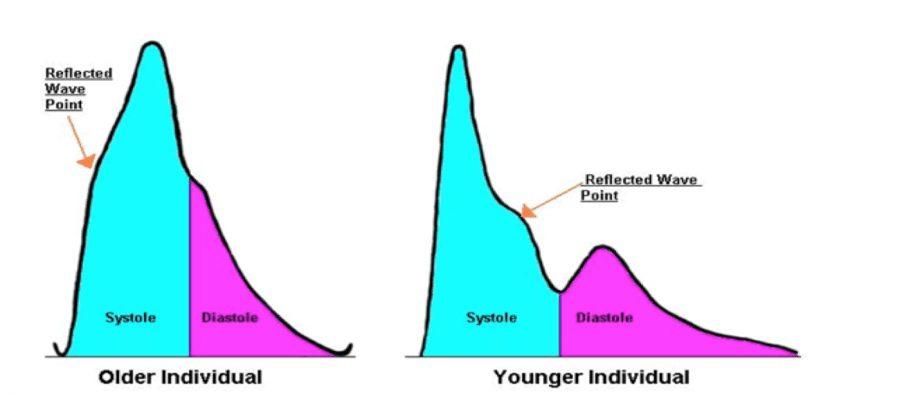
The Reflected Wave seen in both pulses is a wave that originates with the heart beat, travels down the Aorta and reflects back towards the heart as it nears the far end of the Aorta.
The Reflected Wave returns to the heart in a young individual just as the heart finishes a contraction and is about to start its relaxation phase. The Reflected Wave maintains pressure in the Aorta as the heart muscle relaxes, driving blood into the Coronary Arteries in order to feed the heart muscle. In an older individual, the Reflected Wave travels faster along a stiffer Aorta, returning early while the heart is still in its contraction phase. This early return increases blood pressure, increases the heart's workload and decreases blood flow to the heart during its relaxation phase. These effects have a profound influence on the development of heart disease.
The Reflected Wave continues on to the finger and with the use of advanced optical and signal analysis techniques can be clearly seen in the pulse wave of every individual. By characterizing the Reflected Wave in the fingertip pulse signal it is possible to calculate Aortic Pulse Wave Velocity, the method used by scientists to measure Aortic Stiffness. Noted below are two diagrams showing how the reflected wave, even when very subtle, can be located and characterized using pulse signal analysis. In the first diagram, the Reflected Wave is circled in green. The red vertical lines indicate the onset of the Reflected Wave.
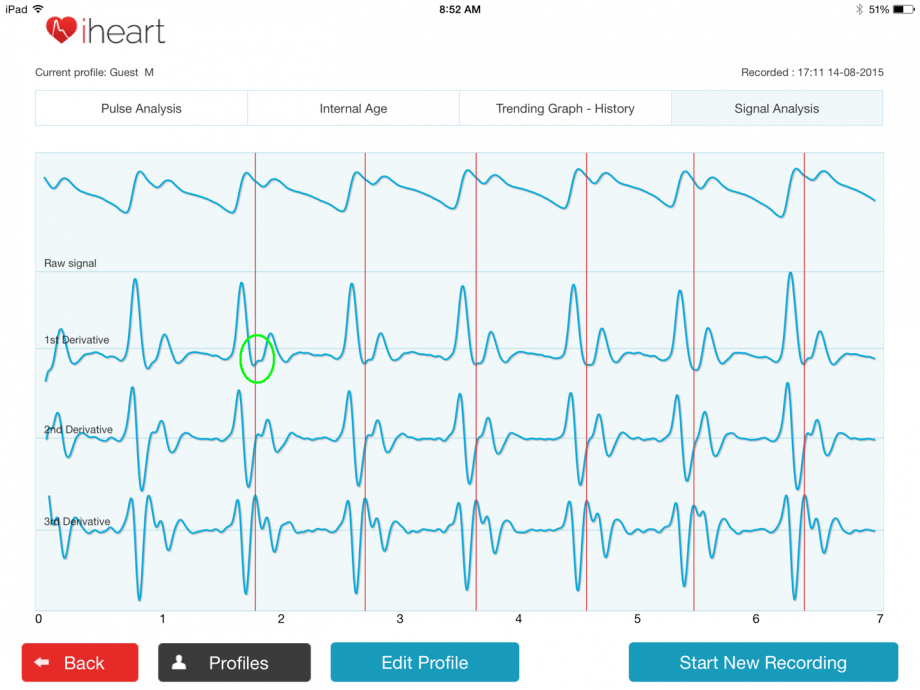
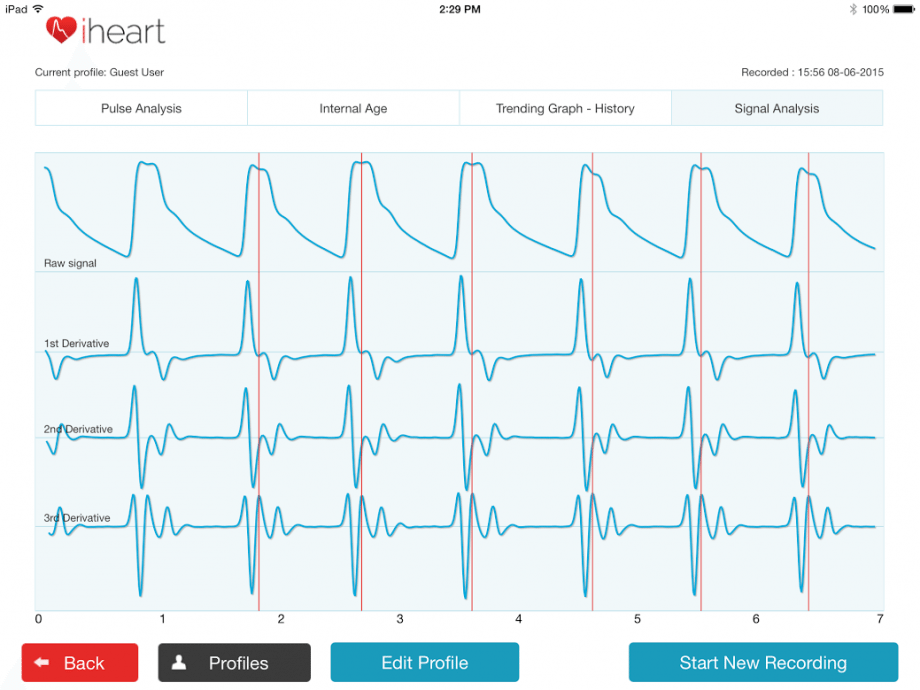
With a small team, a company I founded developed a small and affordable fingertip optical sensor to measure Aortic Stiffness called iHeart www.goiheart.com. iHeart has been tested against the Sphygmocor 'gold standard' Aortic Stiffness measurement system and found to correlate well.
[caption id="attachment_25072" align="aligncenter" width="356"] Click here to learn more.
[/caption]
Click here to learn more.
[/caption]
My goal now is to help people recognize how important movement is to health and how effectively exercise maintains and restores health. Research has shown that people with greatest Aortic Stiffness show improvement most rapidly once they start exercising regularly. It is never too late to start!
Walking, particularly in natural and hilly areas are the most effective way to improve Aortic Stiffness. All exercise that involves the entire body and allows the spine to stretch and bend is also effective. Yoga and Tai Chi are particularly effective in helping people understand how the human body is connected and how movement nourishes the body and leads to long life. Yoga and Tai Chi offer people a set of movements that efficiently work the entire body and improve Core Mobility.
https://www.youtube.com/watch?v=3d9nG4fmpP8
Diet is also important. Hydration keeps the tissues elastic. Research has shown that consumption of foods containing Omega-3 fatty acids improves Aortic Stiffness. Eating slowly and thoughtfully improves the digestive process, reducing abdominal tension affecting Aortic Stiffness.
Reduction of Blood Pressure lowers Aortic Pulse Wave Velocity and slows down travel of the Aortic Reflected Wave. Lowering Blood pressure, using stress management and other natural means, is beneficial for health and longevity.
[divider style="dashed" top="30" bottom="30"]
Jess is a Physician in General Practice with over 20 years experience in worn personal health monitoring electronics development and deployment. He is passionate about giving individuals better ways to visualize, monitor, and manage their health. Dr. Goodman spent years working to make Aortic Stiffness and Core Mobility concept accessible and useful for people around the world. After many years, he and the iheart team developed the iheart Internal Age System.
[divider style="dashed" top="30" bottom="30"]

What is Aortic Stiffness and What Does it Mean to Me?
Aortic Stiffness is a novel integrative health metric with the ability to act as a bridge, connecting ancient Eastern wisdom and modern medical scientific understanding. Aortic Stiffness has been studied by medical scientists for about twenty years and remarkably predicts the risk of death from all causes. Aortic Stiffness is unique in its ability to assess overall health and estimate lifespan. Aortic Stiffness has also been shown to improve with attention to exercise, diet and stress management. Aortic Stiffness is a single health metric able to guide people towards healthy lifestyle choices.
The Aorta runs from the heart through the chest and abdomen as shown in the picture below.

The Aorta runs immediately in front of the spinal column as shown in the drawing below.

Aortic Stiffness is a measure of stiffness along the spinal axis and as such is a measure of Core Mobility.
The body's organization can be regarded as consisting of four cavities as shown below. The cavities define the body’s core regions and mobility of these regions is Core Mobility.

Aortic Stiffness and how it affects our internal health
Each of these internal cavities relies on movement to maintain organ function and health. The spine connects these cavities and spinal stiffness affects the stiffness of the rib cage, soft tissue, skull and pelvic structures. With increasing stiffness of the spine and rib cage, movement of the diaphragm (separating the chest and abdominal cavities) is restricted.
The diaphragm muscle contracts with each breath, compressing the sponge-like liver, spleen, kidneys and other internal organs. Rhythmic breathing related compression and release cycles create a flow of essential fluids and nutrients through the myriad of small channels within the internal organs. This internal organ circulation supports organ function, overall health, and longevity.
With each breath, there are pressure changes in the spinal cord driving cerebrospinal fluid in a long loop to the brain and back again, allowing frond-like areas deep within the brain to filter and maintain the purity of the fluid nourishing the brain. Core Mobility is essential for brain health and maintenance of cognitive function.
The ancient Chinese had a system of physiology using the spine as the organizing principle with body cavities represented metaphorically. This approach is described in the Nei Jing diagram carved on a stone that is on display at the White Cloud Temple in Beijing and shown in the image below.

I studied Tai Chi under the guidance of a Taoist Monk for over twenty years. Towards the end of his life, he asked me to show people health benefits associated with stretching between the heart and the kidneys. This simple request prompted years of exploration and experimentation. Conventional equipment to measure Aortic Stiffness uses multiple arterial pressure sensors, requires a skilled technician and costs over $20,000 USD. A picture of an Aortic Stiffness measurement system is shown below.

My goal was to provide people with a simple and affordable alternative allowing ordinary people to monitor Aortic Stiffness and recognize the health benefits of stretching along the spinal axis.
[box type="info" align="" class="" width=""]
What is Aortic Pulse Wave Velocity AND Why Does it Matter?
https://youtu.be/Cjes1x_sG64
[/box]
The breakthrough occurred when I noted that the shape of the fingertip pulse wave is determined largely by Aortic Stiffness. Characteristic fingertip pulse waveforms from an Older and a Younger individual is noted below.

The Reflected Wave seen in both pulses is a wave that originates with the heart beat, travels down the Aorta and reflects back towards the heart as it nears the far end of the Aorta.
The Reflected Wave returns to the heart in a young individual just as the heart finishes a contraction and is about to start its relaxation phase. The Reflected Wave maintains pressure in the Aorta as the heart muscle relaxes, driving blood into the Coronary Arteries in order to feed the heart muscle. In an older individual, the Reflected Wave travels faster along a stiffer Aorta, returning early while the heart is still in its contraction phase. This early return increases blood pressure, increases the heart's workload and decreases blood flow to the heart during its relaxation phase. These effects have a profound influence on the development of heart disease.
The Reflected Wave continues on to the finger and with the use of advanced optical and signal analysis techniques can be clearly seen in the pulse wave of every individual. By characterizing the Reflected Wave in the fingertip pulse signal it is possible to calculate Aortic Pulse Wave Velocity, the method used by scientists to measure Aortic Stiffness. Noted below are two diagrams showing how the reflected wave, even when very subtle, can be located and characterized using pulse signal analysis. In the first diagram, the Reflected Wave is circled in green. The red vertical lines indicate the onset of the Reflected Wave.


With a small team, a company I founded developed a small and affordable fingertip optical sensor to measure Aortic Stiffness called iHeart www.goiheart.com. iHeart has been tested against the Sphygmocor 'gold standard' Aortic Stiffness measurement system and found to correlate well.
[caption id="attachment_25072" align="aligncenter" width="356"]
 Click here to learn more.
[/caption]
Click here to learn more.
[/caption]My goal now is to help people recognize how important movement is to health and how effectively exercise maintains and restores health. Research has shown that people with greatest Aortic Stiffness show improvement most rapidly once they start exercising regularly. It is never too late to start!
Walking, particularly in natural and hilly areas are the most effective way to improve Aortic Stiffness. All exercise that involves the entire body and allows the spine to stretch and bend is also effective. Yoga and Tai Chi are particularly effective in helping people understand how the human body is connected and how movement nourishes the body and leads to long life. Yoga and Tai Chi offer people a set of movements that efficiently work the entire body and improve Core Mobility.
https://www.youtube.com/watch?v=3d9nG4fmpP8
Diet is also important. Hydration keeps the tissues elastic. Research has shown that consumption of foods containing Omega-3 fatty acids improves Aortic Stiffness. Eating slowly and thoughtfully improves the digestive process, reducing abdominal tension affecting Aortic Stiffness.
Reduction of Blood Pressure lowers Aortic Pulse Wave Velocity and slows down travel of the Aortic Reflected Wave. Lowering Blood pressure, using stress management and other natural means, is beneficial for health and longevity.
Aortic Stiffness is a remarkable new way to assess overall health and lifespan. It can now be measured using simple and affordable equipment designed for people without any medical knowledge. Monitoring Aortic Stiffness will help people objectively recognize the health benefits of wise lifestyle choices and start to make exercise, good diet and stress management a part of every day’s approach to life and longevity.
[divider style="dashed" top="30" bottom="30"]
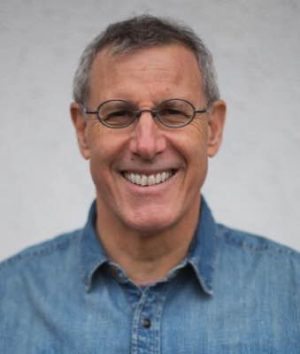 Author Bio: Dr. Jess Goodman
Author Bio: Dr. Jess Goodman
Jess is a Physician in General Practice with over 20 years experience in worn personal health monitoring electronics development and deployment. He is passionate about giving individuals better ways to visualize, monitor, and manage their health. Dr. Goodman spent years working to make Aortic Stiffness and Core Mobility concept accessible and useful for people around the world. After many years, he and the iheart team developed the iheart Internal Age System.
[divider style="dashed" top="30" bottom="30"]




































































































